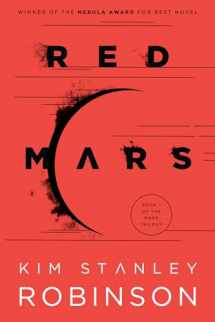
Red Mars (Mars Trilogy)
Book details
Summary
Description
Product Description
Winner of the Nebula Award for Best Novel • Discover the novel that launched one of science fiction’s most beloved, acclaimed, and awarded trilogies: Kim Stanley Robinson’s masterly near-future chronicle of interplanetary colonization.
“A staggering book . . . the best novel on the colonization of Mars that has ever been written.”—Arthur C. Clarke
For centuries, the barren, desolate landscape of the red planet has beckoned to humankind. Now a group of one hundred colonists begins a mission whose ultimate goal is to transform Mars into a more Earthlike planet. They will place giant satellite mirrors in Martian orbit to reflect light onto its surface. Black dust sprinkled on the polar caps will capture warmth and melt the ice. And massive tunnels drilled into the mantle will create stupendous vents of hot gases. But despite these ambitious goals, there are some who would fight to the death to prevent Mars from ever being changed.
Review
“Absorbing . . . a scientifically informed imagination of rare ambition at work.”
—The New York Times Book Review
“Tremendous . . . a high-water mark in novels of Earth emigration.”
—The Washington Post Book World
About the Author
Kim Stanley Robinson is a winner of the Hugo, Nebula, and Locus awards. He is the author of more than twenty books, including the bestselling Mars trilogy and the critically acclaimed
Forty Signs of Rain, Fifty Degrees Below, Sixty Days and Counting, The Years of Rice and Salt, and
Galileo’s Dream. In 2008 he was named one of
Time magazine’s “Heroes of the Environment.” He serves on the board of the Sierra Nevada Research Institute. He lives in Davis, California.
Excerpt. © Reprinted by permission. All rights reserved.
“And so we came here. But what they didn’t realize was that by the time we got to Mars, we would be so changed by the voyage out that nothing we had been told to do mattered anymore. It wasn’t like submarining or settling the Wild West—it was an entirely new experience, and as the flight of the Ares went on, the Earth finally became so distant that it was nothing but a blue star among all the others, its voices so delayed that they seemed to come from a previous century. We were on our own; and so we became fundamentally different beings.”
All lies, Frank Chalmers thought irritably. He was sitting in a row of dignitaries, watching his old friend John Boone give the usual Boone Inspirational Address. It made Chalmers weary. The truth was the trip to Mars had been the functional equivalent of a long train ride. Not only had they not become fundamentally different beings, they had actually become more like themselves than ever, stripped of habits until they were left with nothing but the naked raw material of their selves. But John stood up there waving a forefinger at the crowd, saying, “We came here to make something new, and when we arrived our earthly differences fell away, irrelevant in this new world!” Yes, he meant it all literally. His vision of Mars was a lens that distorted everything he saw, a kind of religion. He would spout the same nonsense in private conversation, no matter how you rolled your eyes.
Chalmers stopped listening and let his gaze wander over the new city. They were going to call it Nicosia. It was the first town of any size to be built freestanding on the Martian surface; all the buildings were set inside what was in effect an immense clear tent, supported by a nearly invisible frame, and placed on the rise of Tharsis, west of Noctis Labyrinthus. This location gave it a tremendous view, with a distant western horizon punctuated by the broad peak of Pavonis Mons. For the Mars veterans in the crowd it was giddy stuff: they were on the surface, they were out of the trenches and mesas and craters, they could see forever! Hurrah!
A laugh from the audience drew Frank’s attention back to his old friend. John Boone had a slightly hoarse voice and a friendl


We would LOVE it if you could help us and other readers by reviewing the book
Book review



